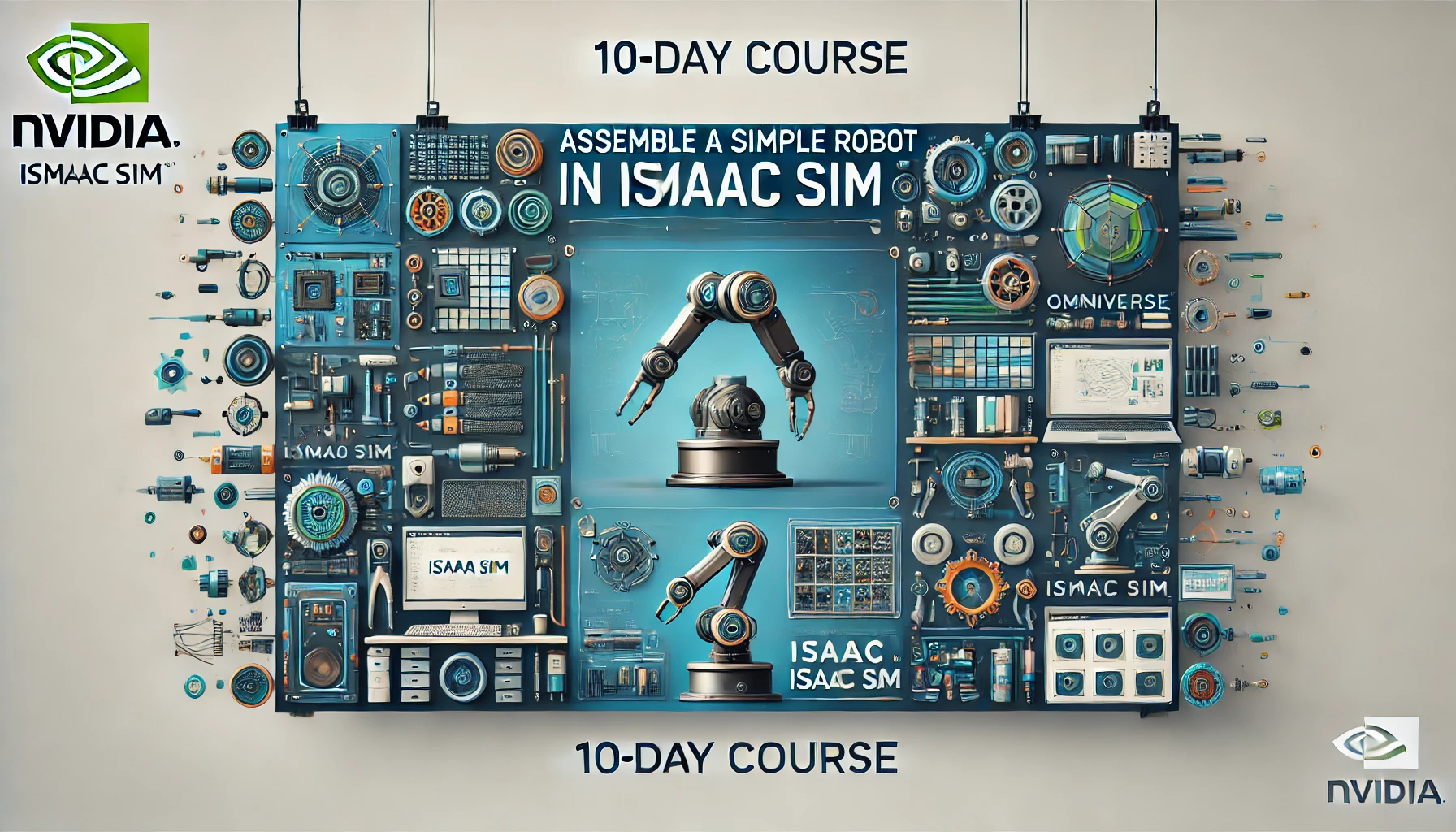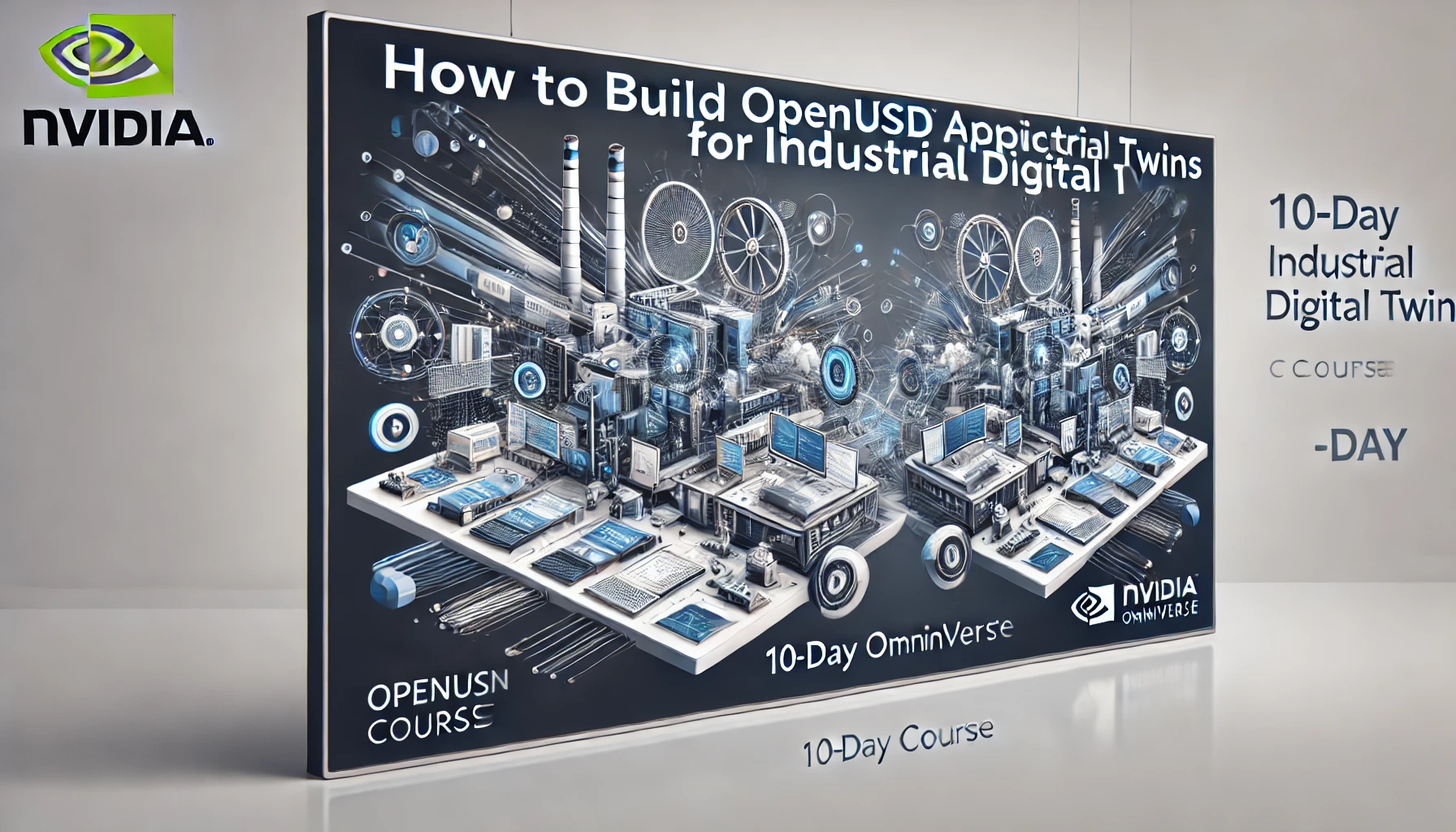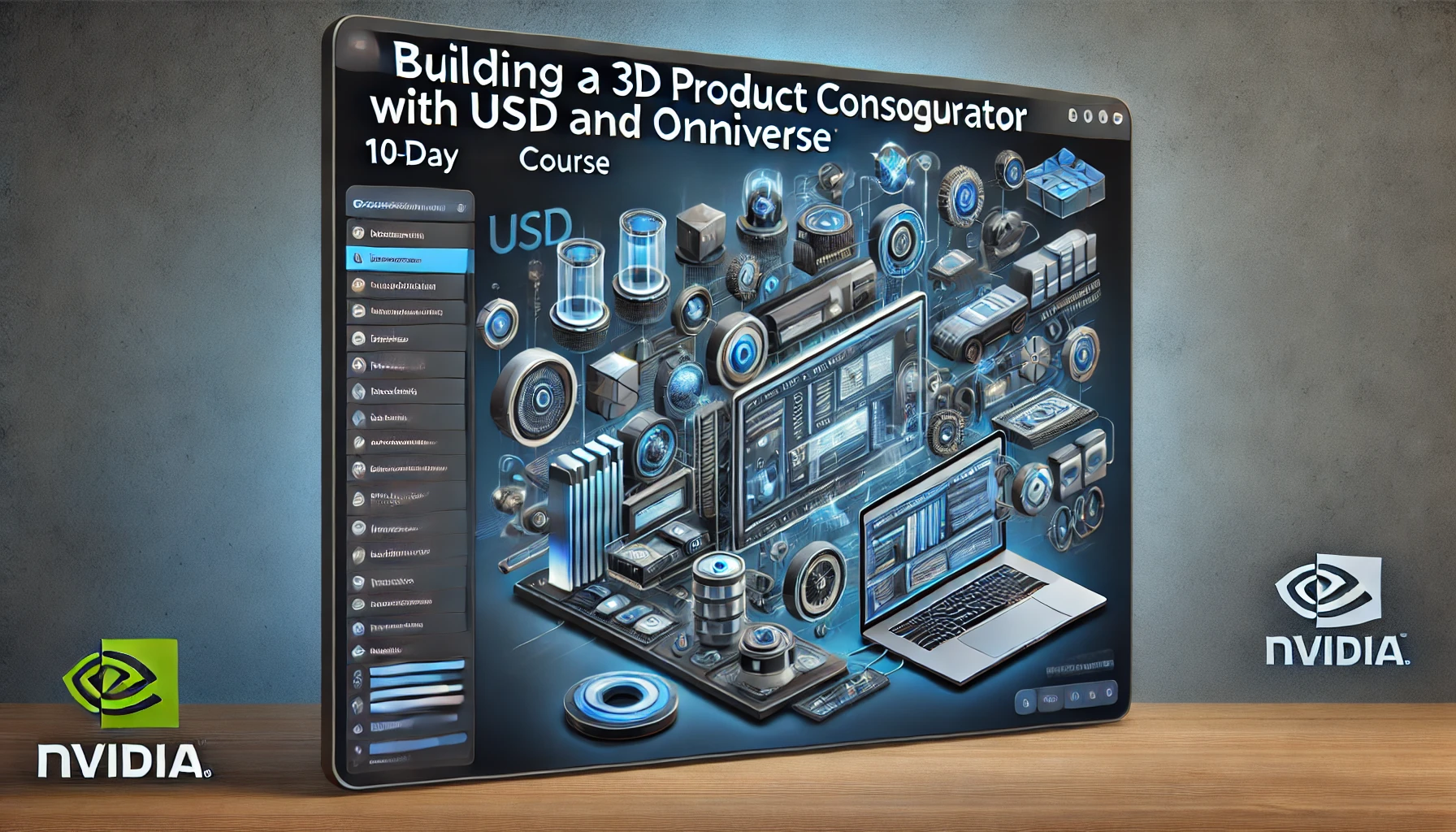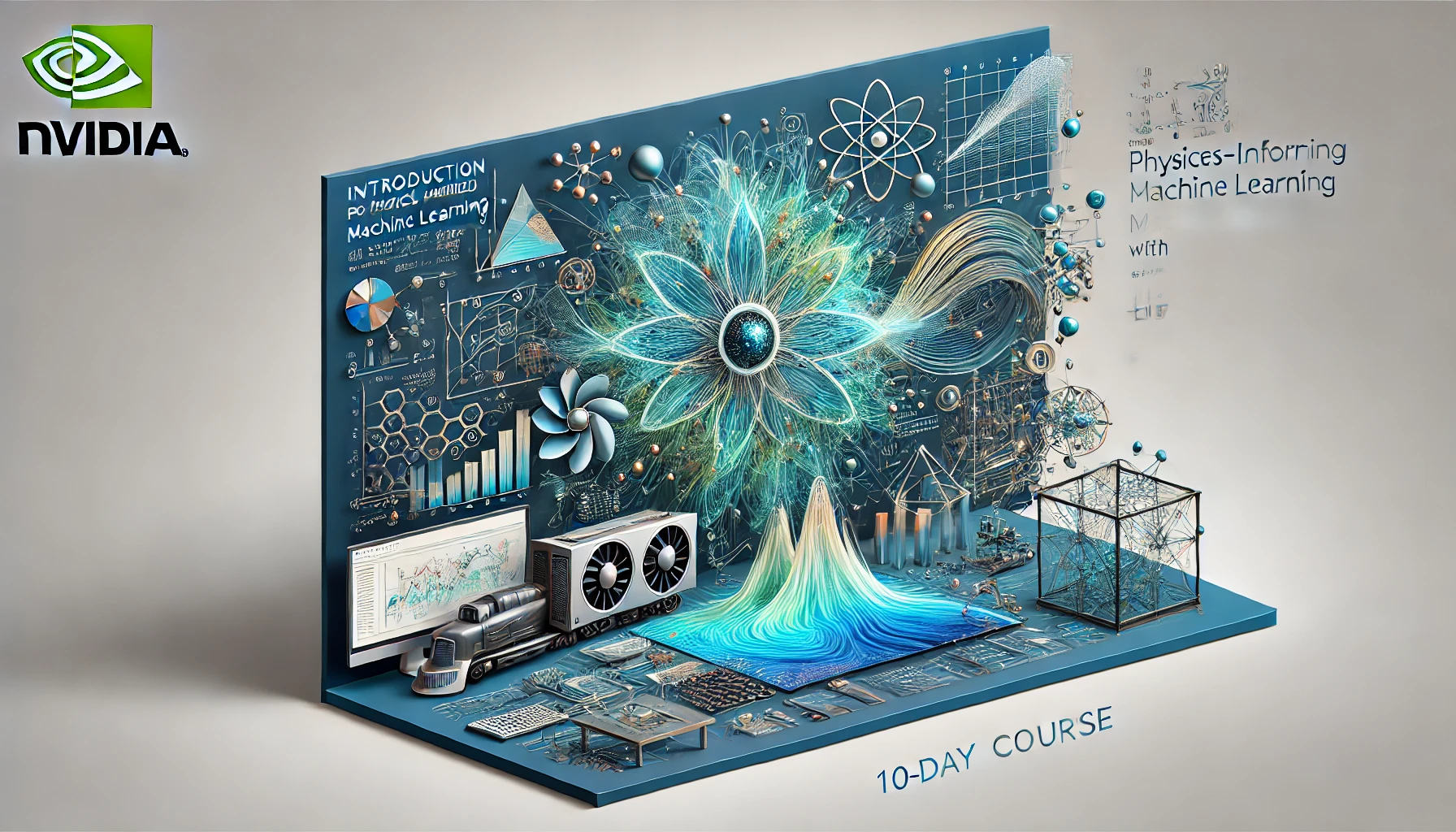Assemble a Simple Robot in Isaac Sim
1. About the Course
“Assemble a Simple Robot in Isaac Sim” is a hands-on 10-day course designed to introduce participants to the world of robotics simulation using NVIDIA Omniverse™ Isaac Sim. Isaac Sim is a powerful platform that enables developers, engineers, and robotics enthusiasts to simulate, test, and optimize robots in a realistic virtual environment. This course provides a step-by-step guide to building and simulating a simple robot from scratch, using the tools and features offered by Isaac Sim.
Throughout this course, participants will gain practical experience in robot assembly, configuration, and simulation. They will learn how to use Isaac Sim’s advanced features, such as physics-based simulation and sensor integration, to create accurate and functional robotic models. By the end of the course, participants will be equipped with the knowledge and skills needed to design and test robots in a virtual environment, preparing them for real-world robotics development.
2. Learning Objectives
By the end of this course, participants will be able to:
- Understand the basics of NVIDIA Omniverse™ Isaac Sim: Gain a solid understanding of the platform’s capabilities and how it can be used for robotics simulation.
- Assemble a simple robot model: Learn the fundamentals of robot assembly, including the use of joints, actuators, and sensors.
- Simulate robot behavior: Configure and simulate the robot’s behavior in a virtual environment using Isaac Sim’s physics engine.
- Integrate sensors into the robot model: Learn how to add and configure sensors, such as cameras and LiDAR, to the robot model.
- Test and optimize robot performance: Use Isaac Sim’s tools to test the robot’s performance and make necessary optimizations.
- Export and share robotic models: Learn how to export and share your robot models for collaboration and further development.
3. Course Prerequisites
This course is designed for individuals with a basic understanding of robotics and simulation. The prerequisites include:
- Basic Knowledge of Robotics: Familiarity with basic robotics concepts, including kinematics, dynamics, and sensors.
- Understanding of 3D Modeling: Basic experience with 3D modeling software or environments will be helpful.
- Experience with Simulation Tools: While not required, previous experience with simulation tools or platforms is beneficial.
- General Programming Knowledge: Familiarity with programming concepts, particularly in Python, will be advantageous.
4. Course Outlines
This course is structured to progressively build your expertise in using NVIDIA Omniverse™ Isaac Sim for robotics simulation. The content is organized as follows:
- Introduction to NVIDIA Omniverse™ Isaac Sim: Overview of the platform, its features, and its applications in robotics.
- Setting Up the Isaac Sim Environment: Installation and configuration of the necessary software tools, including Isaac Sim.
- Understanding Robot Components: Introduction to the basic components of a robot, including joints, actuators, and sensors.
- Assembling a Simple Robot: Step-by-step guide to assembling a simple robot model using Isaac Sim.
- Simulating Robot Movements: Configuring and simulating the robot’s movements in a virtual environment.
- Integrating Sensors into the Robot Model: Adding and configuring sensors such as cameras, LiDAR, and IMUs.
- Testing and Optimizing Robot Performance: Using Isaac Sim’s tools to test and optimize the robot’s performance.
- Advanced Simulation Techniques: Exploring advanced features of Isaac Sim, including reinforcement learning and real-time simulation.
- Exporting and Sharing Robotic Models: Learning how to export and share your robotic models with others.
- Capstone Project: A hands-on project that involves assembling, simulating, and optimizing a robot model using Isaac Sim.
5. Day-by-Day Breakdown
Day 1: Introduction to NVIDIA Omniverse™ Isaac Sim
- Objectives: Understand the basics of Isaac Sim and its role in robotics simulation.
- Topics:
- Overview of NVIDIA Omniverse™ Isaac Sim
- Key features and capabilities of the platform
- Applications of Isaac Sim in robotics and industry
- Activities:
- Reading materials on Isaac Sim’s features and applications
- External link: NVIDIA Isaac Sim Overview
- Internal link: Regent Studies Robotics Courses
Day 2: Setting Up the Isaac Sim Environment
- Objectives: Install and configure Isaac Sim for robot assembly and simulation.
- Topics:
- Installing Isaac Sim on your system
- Setting up the development environment
- Navigating the Isaac Sim user interface
- Activities:
- Step-by-step installation and configuration guide
- Verifying the setup with sample simulations
Day 3: Understanding Robot Components
- Objectives: Learn about the basic components that make up a robot, including joints, actuators, and sensors.
- Topics:
- Introduction to robotic joints and actuators
- Understanding sensor integration in robotic models
- Overview of robotic kinematics and dynamics
- Activities:
- Exploring sample robot models in Isaac Sim
- Analyzing the components of existing robotic models
Day 4: Assembling a Simple Robot
- Objectives: Assemble a simple robot model using the tools and features in Isaac Sim.
- Topics:
- Step-by-step guide to building a robotic model
- Configuring joints, actuators, and sensors
- Ensuring proper assembly and functionality of the robot
- Activities:
- Hands-on assembly of a simple robot model in Isaac Sim
- Testing basic movements and functions of the assembled robot
Day 5: Simulating Robot Movements
- Objectives: Configure and simulate the robot’s movements in a virtual environment using Isaac Sim’s physics engine.
- Topics:
- Introduction to physics-based simulation in Isaac Sim
- Configuring movement parameters for the robot
- Running simulations and analyzing results
- Activities:
- Simulating basic movements and tasks with the robot model
- Analyzing the impact of different configurations on performance
Day 6: Integrating Sensors into the Robot Model
- Objectives: Add and configure sensors to enhance the robot’s functionality and simulation accuracy.
- Topics:
- Overview of sensor types and their applications
- Integrating cameras, LiDAR, and IMUs into the robot model
- Configuring sensor parameters for accurate simulation
- Activities:
- Adding sensors to the robot model and testing their functionality
- Simulating sensor data and analyzing the output
Day 7: Testing and Optimizing Robot Performance
- Objectives: Use Isaac Sim’s tools to test the robot’s performance and make necessary optimizations.
- Topics:
- Performance testing and analysis in Isaac Sim
- Identifying and resolving performance bottlenecks
- Optimizing the robot model for better simulation results
- Activities:
- Running performance tests and making optimizations
- Comparing simulation results before and after optimization
Day 8: Advanced Simulation Techniques
- Objectives: Explore advanced features of Isaac Sim, including reinforcement learning and real-time simulation.
- Topics:
- Introduction to reinforcement learning in Isaac Sim
- Real-time simulation and its applications in robotics
- Using advanced features to enhance simulation accuracy
- Activities:
- Implementing basic reinforcement learning tasks with the robot model
- Exploring real-time simulation scenarios
Day 9: Exporting and Sharing Robotic Models
- Objectives: Learn how to export and share your robotic models for collaboration and further development.
- Topics:
- Exporting robotic models in various formats
- Sharing models with collaborators or across platforms
- Best practices for version control and collaboration
- Activities:
- Exporting the assembled robot model in a chosen format
- Sharing the model and collaborating with others
Day 10: Capstone Project
- Objectives: Apply all the knowledge gained throughout the course to assemble, simulate, and optimize a robot model using Isaac Sim.
- Topics:
- Project planning and design
- Building and simulating a complex robot model
- Optimizing and presenting the final project
- Activities:
- Work on a real-world project that involves assembling and simulating a robot model
- Present the project and discuss the results with peers
6. Learning Outcomes
By the end of “Assemble a Simple Robot in Isaac Sim,” participants will be able to:
- Assemble a robot model using Isaac Sim: Confidently use Isaac Sim’s tools to build and configure a robotic model from scratch.
- Simulate robot movements and behaviors: Apply physics-based simulation to test and analyze the robot’s movements and behaviors in a virtual environment.
- Integrate and configure sensors: Add and configure various sensors to the robot model, enhancing its functionality and simulation accuracy.
- Optimize robotic performance: Use Isaac Sim’s tools to test, analyze, and optimize the performance of the robot model for better results.
- Utilize advanced simulation techniques: Explore and implement advanced features of Isaac Sim, such as reinforcement learning and real-time simulation.
- Export and share robotic models: Learn how to export and share your robotic models for collaboration and further development.
Participants will complete the course with a comprehensive understanding of NVIDIA Omniverse™ Isaac Sim, practical experience in robot assembly and simulation, and the ability to design and optimize robotic models for real-world applications. This course is essential for anyone looking to expand their skills in robotics and simulation.
This course outline is designed to provide an engaging, informative, and structured learning experience, ensuring that participants gain the skills and knowledge necessary to excel in robotics simulation with NVIDIA Omniverse™ Isaac Sim. Whether you are a beginner or an experienced developer, this course offers the tools and insights needed to succeed in the exciting field of robotics.




